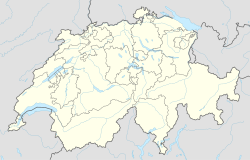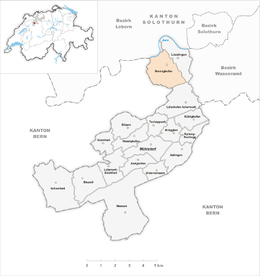Nennigkofen
| Nennigkofen | ||
|---|---|---|
| Former municipality of Switzerland | ||

Nennigkofen school house
|
||
|
||
| Coordinates: 47°11′N 7°30′E / 47.183°N 7.500°ECoordinates: 47°11′N 7°30′E / 47.183°N 7.500°E | ||
| Country | Switzerland | |
| Canton | Solothurn | |
| District | Bucheggberg | |
| Area | ||
| • Total | 4.62 km2 (1.78 sq mi) | |
| Elevation | 456 m (1,496 ft) | |
| Population (Dec 2011) | ||
| • Total | 484 | |
| • Density | 100/km2 (270/sq mi) | |
| Postal code | 4574 | |
| SFOS number | 2459 | |
| Surrounded by | Leuzigen (BE), Lüterkofen-Ichertswil, Selzach | |
| Website | SFSO statistics |
|
Nennigkofen is a former municipality in the district of Bucheggberg, in the canton of Solothurn, Switzerland. On 1 January 2013, Lüsslingen and Nennigkofen merged to form Lüsslingen-Nennigkofen.
Nennigkofen is first mentioned in 1392 as Nennikofen or Nennikoven.
Nennigkofen had an area, as of 2009[update], of 4.62 square kilometers (1.78 sq mi). Of this area, 2.97 km2 (1.15 sq mi) or 64.3% is used for agricultural purposes, while 1.11 km2 (0.43 sq mi) or 24.0% is forested. Of the rest of the land, 0.36 km2 (0.14 sq mi) or 7.8% is settled (buildings or roads), 0.13 km2 (32 acres) or 2.8% is either rivers or lakes and 0.01 km2 (2.5 acres) or 0.2% is unproductive land.
Of the built up area, housing and buildings made up 4.1% and transportation infrastructure made up 3.0%. Out of the forested land, 22.3% of the total land area is heavily forested and 1.7% is covered with orchards or small clusters of trees. Of the agricultural land, 46.3% is used for growing crops and 16.2% is pastures, while 1.7% is used for orchards or vine crops. All the water in the municipality is flowing water.
The former municipality is located in the Bucheggberg district. Nennigkofen and the neighboring municipality of Lüsslingen form the Bucheggberger Aare valley.
The blazon of the municipal coat of arms is Or an Ear of the same on a Bend sinister Gules.
Nennigkofen had a population (as of 2011[update]) of 484. As of 2008[update], 9.1% of the population are resident foreign nationals. Over the last 10 years (1999–2009 ) the population has changed at a rate of 3.9%.
...
Wikipedia




